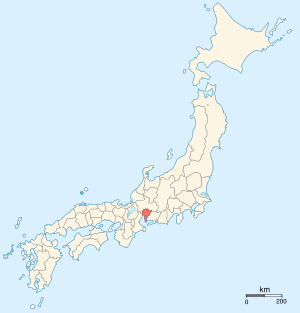Owari Province

Owari Province (尾張国, Owari no Kuni) was a province of Japan in the area that today forms the western half of Aichi Prefecture, including the modern city of Nagoya.[1] The province was created in 646. Owari bordered on Mikawa, Mino, and Ise Provinces. Owari and Mino provinces were separated by the Sakai River, which means "border river." The province's abbreviated name was Bishū (尾州).

Owari is classified as one of the provinces of the Tōkaidō. Under the Engishiki classification system, Owari was ranked as a "superior country" (上国) and a "near country" (近国), in relation to its distance from the capital.
History
Owari is mentioned in records of the
Under the Engishiki classification system, Owari was divided into eight counties, which persisted as administrative units into the Edo period. The exact location of the provincial capital is not known, but is traditionally considered to have been located in what is now the city of
During the
Under
Following the abolition of the han system in 1871 after the Meiji Restoration, former Owari Domain and Inuyama Domain were transformed into short-lived prefectures, which were joined with Nukata Prefecture, which was the former Mikawa Province, to form the new Aichi Prefecture in January 1872. At the same time, the province continued to exist for some purposes. For example, Owari is explicitly recognized in treaties in 1894 (a) between Japan and the United States and (b) between Japan and the United Kingdom.[3]
Bakumatsu-period domains in Owari Province
| Domain | Daimyō | Dates | Revenue (koku) | Type |
|---|---|---|---|---|
| Owari Domain (尾張藩) | Tokugawa | 1607–1871 | 619,500 | shimpan |
| Inuyama Domain (犬山藩) | Naruse | 1617–1871 | 35,000 | fudai |
Historical districts
Owari Province consisted of eleven districts:
- Aichi Prefecture
- Aichi District(愛知郡)
- Chita District(知多郡)
- Haguri District(葉栗郡) – dissolved
- Kasugai District (春日井郡)
- Higashikasugai District(東春日井郡) – dissolved
- Nishikasugai District(西春日井郡)
- Ama District(海部郡) on April 4, 1913
- Kaitō District (海東郡; East Ama) – merged with Kaisei District to Ama District on April 4, 1913
- Nakashima District(中島郡) – dissolved
- Niwa District(丹羽郡)
- Yana District(八名郡) – dissolved
Notes
- .
- ^ "Kiyosu Castle". Kiyosu City. Archived from the original on 2008-02-09. Retrieved 2010-11-07.
- ^ US Department of State. (1906). A digest of international law as embodied in diplomatic discussions, treaties and other international agreements (John Bassett Moore, ed.), Vol. 5, p. 759.
References
- Papinot, Edmond. (1910). Historical and Geographic Dictionary of Japan. Tokyo: Librarie Sansaisha. OCLC 77691250
External links
![]() Media related to Owari Province at Wikimedia Commons
Media related to Owari Province at Wikimedia Commons
